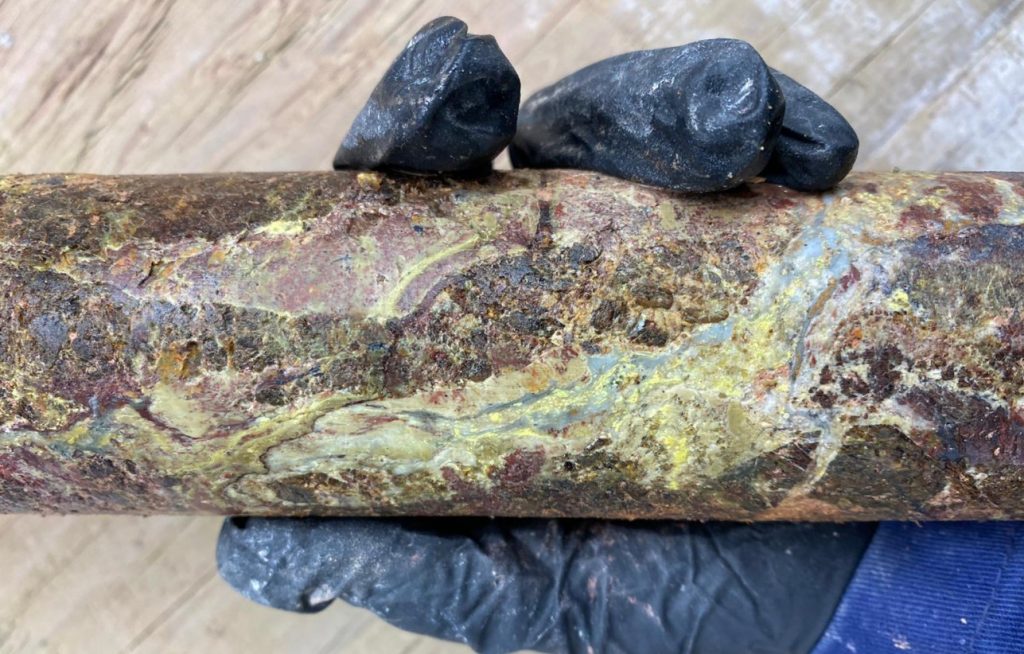Baselode Energy drills 1.11% U3O8 over 7.4 metres at Hook, Saskatchewan

Baselode Energy Corp. [TSXV-FIND; OTCQB-BSENF] reported new uranium (U3O8) assays from five drill holes from the 7,512-metre diamond drilling program completed within the Ackio uranium prospect on the Hook project, Saskatchewan. Assays from the remaining 15 drill holes cover shallow mineralization expanding Pod 7, and exploration drill holes outside the known Ackio footprint.
“Ackio continues to impress us with near-surface, high-grade uranium mineralization in Pod 1, and with growth potential in Pod 7 starting to be realized. Drill holes AK23-095, AK23-096, and AK23-098 intersected mineralization starting within 50 m of surface and had greater than 30 m of composite mineralization. This demonstrates the potential of Ackio as it hosts shallow, high-grade uranium and is endowed with multiple thick sequences of mineralization. In addition, Pod 7 has grown in thickness, depth, and strike length with four drill holes, remaining open at depth and along strike. We anticipate more encouraging results from Pod 7 as the highest levels of radioactivity encountered in the Program were drilled 50 m along strike of holes AK23-98 and AK23-99,” said James Sykes, CEO, President and Director of Baselode.
A total of 36 drill holes for 7,512 metres were completed during the Program. Ackio consisted of 30 drill holes for 6,193 metres, Mirror consisted of 5 drill holes for 1,145 metres, and 1 drill hole for 174 metres was completed on a regional exploration target.
Drill holes AK23-95, AK23-96, AK23-98 and AK23-99 were drilled within the centre of Pod 1, with the former two drill holes also targeting moderate to deeper portions of Pod 7 to the west, and the latter two drill holes testing the edge of modeled mineralization in Pod 7.
Extensive shallow mineralization starting within 50 m of surface was confirmed in three drill holes in Pod 1, including 0.41% U3O8 over 34.85 m at 46.65 m (43.5 m true vertical depth) from AK23-95 and 0.36% U3O8 over 20.0 m at 54.0 m (49.7 m true vertical depth) from AK23-96.
Drill holes AK23-95 and AK23-98 confirmed extensive mineralization within the main body of Pod 7, including 0.11% U3O8 over 24.5 m at 134.5 m (125.3 m true vertical depth) from AK23-95 and 0.18% U3O8 over 13.0 m at 132.0 m (101.1 m true vertical depth) from AK23-98. These results expanded the modelled width of Pod 7.
Drill holes AK23-96 and AK23-99 intersected significant uranium mineralization below Pod 7, expanding the modelled depth of Pod 7. Pod 7 remains open at depth.
Drill hole AK23-97 tested the gap between Pods 1 and 2 to determine if the two Pods are connected. The drill hole intersected a few minor structures with uranium concentrations below reporting limits but not enough uranium to sufficiently determine Pods 1 and 2 as the same Pod.
Ackio is 30 km southeast of well-established infrastructure, including an all-season road and powerline between Cameco Corp.’s [TSX-CCO] and Orano’s McArthur River mine and Key Lake uranium mill joint ventures. Ackio is 70 km northeast of the Key Lake mill. The program was helicopter-supported to lessen any ground-induced environmental impacts within the project area.
Baselode controls 100% of approximately 264,172 hectares for exploration in the Athabasca Basin area, northern Saskatchewan, Canada. The land package is free of any option agreements or underlying royalties.
The Company discovered the Ackio near-surface, uranium prospect in September 2021. Ackio measures greater than 375 m along strike, greater than 150 metres wide, comprised of at least 9 separate uranium Pods, with mineralization starting as shallow as 28 metres and 32 metres beneath the surface in Pods 1 and 7, respectively, and down to approximately 300 metres depth beneath the surface with the bulk of mineralization occurring in the upper 120 metres. Ackio remains open at depth, and to the north, south and east.
Baselode’s Athabasca 2.0 exploration thesis focuses on discovering near-surface, basement-hosted, high-grade uranium orebodies outside the Athabasca Basin.
